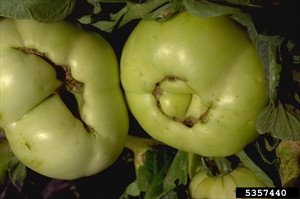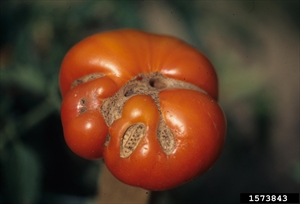- Worldwide. Physiological disorder common wherever tomatoes are grown. A general term for lumps, outgrowths, holes and scar tissue on fruits. The fruits ase still edible; they are just unsightly, and unsaleable.
- Varieties differ in susceptibility, with those producing larger fruit more likely to show symptoms.
- Cause not understood. Several suggestions: initial dry period then long period of rain; alternating dry and wet soils; cold temperatures (<10°C) at night during flowering; large fluctuations in day and night temperatures; excessive N; thrips damaging female parts of flower; excessive pruning indeterminate varieties (lowering auxin concentrations); use of 2,4-D herbicide.
- Cultural control: avoid excessive pruning; do not apply excessive N; avoid planting in seasons when low temperature (<10°C) expected; avoid extremes of wet and dry; use varieties that are less susceptible; use a mulch.








